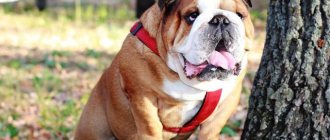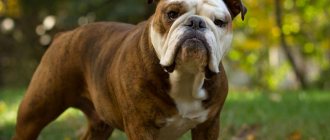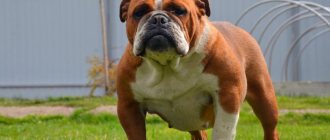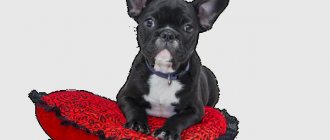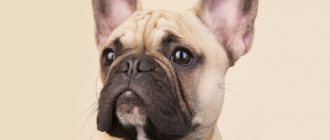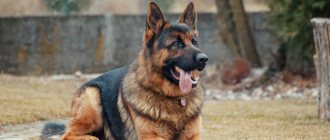Story
Now it’s hard to believe, but modern calm and phlegmatic bulldogs trace the origin of their breed to the Old English bulldogs - formidable fighting dogs specially bred for baiting bulls (as evidenced by the name of the breed - literally translated “bull dog”). The first mention of bulldogs as a separate breed dates back to the 17th century.
These dogs were specially bred for fighting, which determined their appearance and character: stocky, wide chest, short hair, small ears, powerful jaws - as well as high aggressiveness, unquestioning devotion to the owner and immunity to pain.
Bull baiting was banned in Great Britain in 1835, which led to a decline in the popularity of bulldogs. Outside of combat, this breed was simply useless. The demand for dogs fell, and by the middle of the century, bulldogs were on the verge of extinction. However, among the breeders there were connoisseurs of the breed who decided to restore it.
Through considerable efforts of breeders, the least aggressive dogs were selected, which became the ancestors of the updated breed. The English Bulldog was officially recognized by the English Kennel Club in 1873 and within a few years gained popularity not only in its homeland, but throughout Europe. This is such an interesting history of this breed!
The English Bulldog belongs to the Molosser dog , a group that includes herding and guard breeds. And although today he is considered a companion dog, he still has many typical “Molossian” features of body structure, physiology and character.
Lifespan
English Bulldog on a leash
A study conducted by the British Kennel Club and the British Small Animal Veterinary Association found that the average lifespan of the species was 8 years. At the same time, about 9% of animals died from “old age.”
Another 2010 study puts the average life expectancy at 6 years. English Bulldogs were once considered healthy dogs with an average lifespan of 10 years. But today these numbers have decreased and amount to 6-8 years.
The most common causes of death are heart disease (11.8%), cancer (10.9%) and brain disorders (9.1%), and cutaneous folding dermatitis (7.8%).
Description
Let's study a detailed description of the dog breed.
Appearance standard
- The English Bulldog is a short-haired dog with medium-coarse hair that fits tightly to the body.
- color two-color (red and white) is most common brindle, solid (white, red, fawn, reddish-yellow) or smut (solid color with a black muzzle) are also possible. Black, black and tan, and liver colors are considered faulty.
- The Bulldog is a stocky, dense dog with a large, wide head, a thick, powerful neck, a short back, noticeably arched towards the waist, a tucked belly and low, muscular limbs.
- The tail is short, low set, thick at the base.
- muzzle , with a massive square lower jaw noticeably protruding forward.
- The cheeks are protruding, the jowls are thick and dense, covering the jaw on both sides.
- The eyes are widely spaced, medium in size, dark brown in color.
- The ears are small, thin, set high, widely spaced, directed down and back, forward or semi-erect (rose, bud and tulip shapes). The show standard allows only rose-shaped ears ; other shapes are considered faulty.
Bicolor
brindle
Smoot
Our entire editorial team fell in love with this handsome black guy!
Dimensions
The height of a bulldog at the withers can vary from 31 to 40 cm - this parameter is not fixed in canine standards.
How much does it weigh? The average weight of an adult male dog is 23-25 kg, females – 22-23 kg.
As bulldog puppies grow, they gain weight very quickly. The weight dynamics by month is as follows.
Weight table
How much should a bulldog weigh:
- newborn puppies weigh only 300-400 grams. However, their daily weight gain is very significant, and by the end of the first month of life the puppy already weighs about 1.5 kg;
- by the 2nd month, the puppy’s weight almost quadruples – it is just over 4 kg;
- at 3 months, with proper care, the puppy already weighs 8 kg;
- by 4 months the puppy’s weight is 10-11 kg;
- by 5-6 months the puppy turns into a teenager, its body acquires “adult” proportions, and its weight reaches 15-17 kg;
- at 7-9 months, a young bulldog already weighs 19-20 kg;
- in the period from 9 months to a year, the bulldog no longer actively gains weight; The average weight of a one-year-old dog is 21-22 kg.
Barking
An interesting feature of the breed is that English bulldogs practically do not bark. The voice of this dog can be heard very rarely - phlegmatic bulldogs extremely rarely bark even when an unfamiliar person or animal appears. They can be safely left alone for a while - unlike many breeds, bulldogs will not howl and whine while waiting for their owner.
How many years have they lived at home?
The average life expectancy of these dogs, unfortunately, is short - 8-10 years, which is typical for most Molosser dogs. The fact that the bulldog is a very sickly breed, which is characterized by many diseases, both congenital and acquired, also plays a role. But with quality care and timely vaccination, bulldogs live much longer - from 12 to 16 years.
It is important to remember that the quality and life expectancy of a bulldog very much depend on the owner and the efforts he makes.
Tips for choosing a puppy
Choosing a puppy is not an easy task, you need to prepare for it. Think about who you want to take: a family friend and faithful comrade or a real champion? All these nuances will influence your choice.
If possible, contact a specialist - he will accompany you during your visit to the breeder and tell you which English bulldog puppy to get. He will also guide you on the feasibility of the price.
It is necessary to check all the documents for the puppy and make sure that there are no diseases not only in each baby, but also in their parents. Purebred bulldogs should be purchased from special kennels or from trusted breeders.
From one and a half to three months is the ideal age when you should adopt a puppy. Pay attention to his behavior when you first meet him. Shiny eyes and smooth bright fur, a moist nose and a playful look are signs of a healthy puppy that you can safely adopt and not be afraid of the consequences. If the puppy is cowardly or embittered, you should not take such a baby home - it is unlikely that he will be able to become a good friend.
Pros and cons of the breed
Peculiarities
The modern English bulldog is a completely artificial breed with its own unique characteristics. And, like most creations of breeders, it is characterized by many specific diseases.
The most common types of diseases in this breed are:
- diseases of the cardiovascular system (including congenital);
- respiratory tract diseases;
- eye diseases;
- obesity;
- skin diseases;
- allergies;
- oncological diseases.
During the selection process, breeders sought to achieve a certain body structure of the dog - squat and “square”. As a result, in a modern bulldog the main load from body weight falls not on the bones of the legs, but on the muscles. Due to this, bulldogs quickly gain muscle mass, however, such a redistribution of the load requires increased energy expenditure - dogs quickly get tired, suffer from shortness of breath and often have problems with the cardiovascular system. Thus, representatives of this breed often have mitral valve stenosis and stenosis of the pulmonary artery.
Watches your figure!
To restore strength, a bulldog requires many hours of rest and high-calorie food . If not properly controlled, this regimen can lead to an obese dog. The already considerable load on the heart increases even more, the dog ages faster, its life expectancy is reduced, and if the dog had congenital heart diseases, they worsen and begin to progress.
Due to the specific shape of the head – flattened and “square” – many bulldogs develop the so-called brachiocephalic syndrome – shortening and deformation of the airways, leading to breathing problems. The main stages of development of brachiocephalic syndrome are:
- narrowing of the nostrils and nasal passages;
- lengthening and thickening of the soft palate;
- deformation of the larynx.
This condition is a frequent companion of all breeds with short muzzles, not only bulldogs, but also pugs, Pekingese and many others. Brachiocephalic syndrome develops gradually and it is important to catch it early. Timely surgical correction (dilation of the nostrils, resection of an enlarged soft palate) can prevent pathological changes in the larynx.
You can understand that a bulldog is developing brachiocephalic syndrome by the following signs: loud snoring, noisy, hoarse breathing, bubbling in the throat, frequent shortness of breath, even after minor physical exertion. If such signs are detected, the dog should be immediately taken to the veterinarian.
Bulldogs often have diseases and defects of the eyes and eyelids, including congenital ones. These dogs are often diagnosed with diseases such as:
- bilateral cataract;
- “cherry eye” – hypertrophy and prolapse of the gland of the nictitating membrane of the eye;
- eversion or inversion of the eyelid;
- keratitis (“dry eye”) – disruption of the lacrimal gland and decreased production of tear fluid;
- trichiasis - a disorder of eyelash growth in which they are directed towards the eye;
- double eyelashes.
Skin diseases are also found in bulldogs - papillomas and bacterial lesions . They can be easily prevented by caring for your dog, bathing it on time and treating skin folds.
Get well soon, dog
